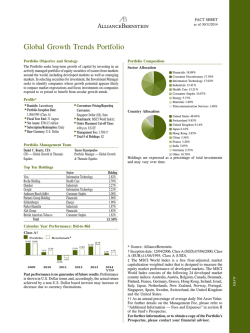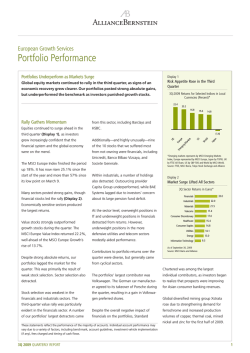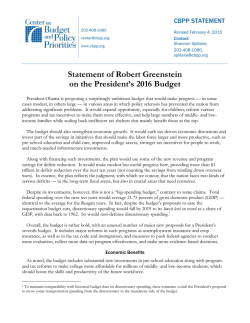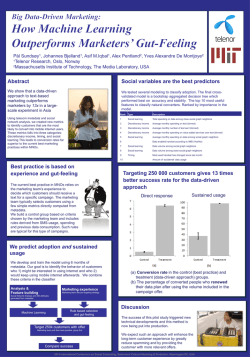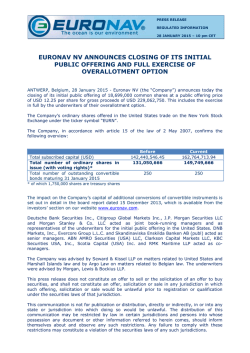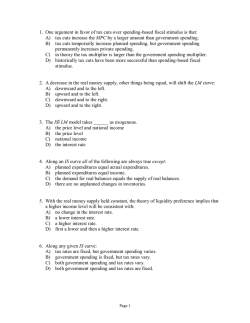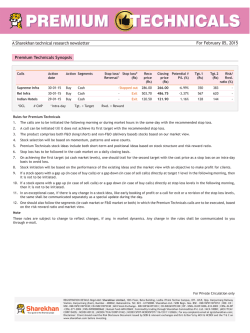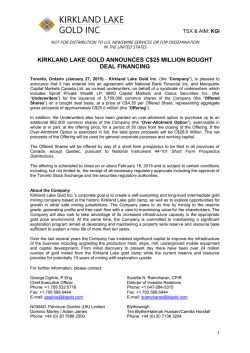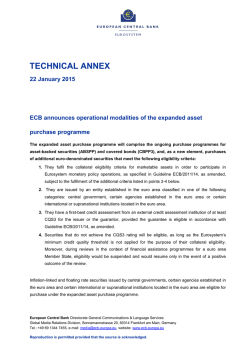
STRONGER US ECONOMY AND IMPLICATIONS FOR FED POLICY
JAN 01.30.2015 ECONOMICS: US PERSPECTIVES STRONGER US ECONOMY AND IMPLICATIONS FOR FED POLICY + Joseph G. Carson, US Economist and Director—Global Economic Research, [email protected] We believe the shift in sectors leading the current growth paints a picture of an economy that’s finally emerging from its subpar pace. And in the January Federal Open Market Committee (FOMC) statement, policymakers acknowledged that improved growth by saying that “economic activity has been expanding at a solid pace.” But there’s an interesting hitch: unlike past years, the US economy is entering 2015 with strong momentum and unexpected stimulus emanating from a sharp drop in oil prices and long-term interest rates. So policymakers will have to balance the faster growth and low-inflation outlook. In the latest FOMC statement, policymakers also noted that they think the drop in inflation is due to transitory factors. That’s why we believe that an official rate hike midyear still appears to be likely. Economy’s Performance The initial report on fourth-quarter real GDP from the US Bureau of Economic Analysis (BEA) shows an annualized gain of 2.6%, slightly below the consensus estimates (and ours) of 3% to 3.5%. Yet, if recent history is any guide, that fourthquarter preliminary estimate will be revised higher when more complete data (including all of December data) are available over the next month or two. The big surprises in this fourth-quarter report were the initial estimates for real merchandise exports and imports. The BEA assumed a very sharp deterioration in the nominal trade deficit in December. Even on the surface, that looks to be questionable: the plunge in oil prices alone should result in a lower nominal deficit. Best Quarterly String of GDP Growth Since 2004 Real Gross Domestic Product 5 Percent Change Annual Rate The strength and composition of gross domestic product (GDP) growth over the past three quarters is very unusual for an economic recovery in its sixth year. To be sure, real GDP growth averaged 4% over the past three quarters. That’s the best in a decade (Display 1). Equally interesting, the mix of that recent growth shows a rotation toward more consumer spending (Display 2) and housing—two sectors that ordinarily record strong gains at the outset of a business cycle, not in the middle or the end. Display 1 4 3 2 1 0 (1) (2) (3) 2010 2011 2012 2013 2014 Through December 31, 2014 Source: Haver Analytics and US Bureau of Economic Analysis (BEA) Display 2 Fourth-Quarter Consumer Spending Gains Broad and Strong Real Personal Consumption Expenditures 4.5 Percent Change Annual Rate Over the past three quarters, the US economy expanded at a 4% annualized rate, the fastest gain in a decade. The economy is also starting 2015 with added stimulus from lower energy prices and the plunge in long-term interest rates. The stronger dollar poses a modest headwind, but domestic demand has picked up and will likely be the main growth engine. Policymakers face a difficult balancing act in the coming months, but we still expect official rates to be lifted at midyear. 4.0 3.5 3.0 2.5 2.0 1.5 1.0 0.5 0.0 2010 2011 2012 Through December 31, 2014 Source: BEA and Haver Analytics 2013 2014 Upcoming data releases will yield better insight for the “true” fourth-quarter growth rate. We believe the initial estimates will be revised to reflect what appears to be an improved (rather than deteriorating) trade balance. Even without any revision, the string of recent quarterly gains in real GDP is quite impressive. The fourth quarter’s annualized gain of 2.6% was preceded by a 5% annualized gain in the third quarter and a 4.6% annualized gain in the second quarter—making this three-quarter string the fastest cumulative gain (+4%) in real GDP growth since late 2003/early 2004. In the fourth quarter, real consumer spending rose 4.3%, its strongest quarterly showing since 2004. Strong gains in consumer spending on durables (+7.4%) led the way, but spending on consumer nondurables (4.4%) and services (3.7%) also posted their biggest quarterly advances in some time. Construction spending also increased, with spending on residential investment increasing 4.1%. Business spending on equipment and software experienced a minor contraction of 1.9%. But spending on industrial equipment declined 12.6%—much of that because of cutbacks in the oil and gas sector. Real fourth-quarter government spending contracted 2.2%, with the drop entirely attributable to the sharp 12.5% decline in defense spending. This pullback was expected, as it followed an unexpected 16% annualized gain in the third quarter. State and local spending advanced 1.3% in the fourth quarter. For the year ending in 4Q, total government spending rose 0.8%. That marks the first annual increase since 2008, and it also indicates an end to the fiscal drag. Monetary Policy The official statement of the January 28 FOMC meeting showed that policymakers characterized the economy as expanding at a “solid pace” and that the labor markets had been generating “strong job gains.” That’s the first time since 2006 that policymakers had described economic growth and labor markets in those (strong and solid) terms. We interpret the statement to mean that policymakers are getting prepared to raise official rates off the zero-interest level. But to do that, they need to see that the fall in headline inflation is, indeed, temporary and does not spill over to core inflation. We expect core inflation to move higher in 2015—a direct result of stronger US consumer markets. The list of factors that policymakers are monitoring includes labor market conditions, indicators of inflation pressure and inflation expectations, and readings on financial and international developments. The items on the list—and their order—are important. As one can see, domestic factors dominate the list. And it’s worth noting that policymakers aren’t oblivious to overseas events and risks, but international developments could move the economy in a better or a worse direction. In the end, we do expect the Fed to be guided by what is happening in the domestic economy. With growth running in the 3.5%–4.0% range and labor markets tightening further in 2015, we are still calling for a midyear official rate hike. n The information contained herein reflects the views of AllianceBernstein L.P. or its affiliates and sources it believes are reliable as of the date of this publication. AllianceBernstein L.P. makes no representations or warranties concerning the accuracy of any data. There is no guarantee that any projection, forecast or opinion in this material will be realized. Past performance does not guarantee future results. The views expressed herein may change at any time after the date of this publication. This document is for informational purposes only and does not constitute investment advice. AllianceBernstein L.P. does not provide tax, legal or accounting advice. It does not take an investor’s personal investment objectives or financial situation into account; investors should discuss their individual circumstances with appropriate professionals before making any decisions. This information should not be construed as sales or marketing material or an offer or solicitation for the purchase or sale of any financial instrument, product or service sponsored by AllianceBernstein or its affiliates. Note to Canadian Readers: AllianceBernstein provides its investment management services in Canada through its affiliates Sanford C. Bernstein & Co., LLC and AllianceBernstein Canada, Inc. Note to European Readers: European readers should note that this document has been issued by AllianceBernstein Limited, which is authorised and regulated in the UK by the Financial Conduct Authority. The registered office of the firm is: 50 Berkeley Street, London W1J 8HA. Note to Australian Readers: This document has been issued by AllianceBernstein Australia Limited (ABN 53 095 022 718 and AFSL 230698). Information in this document is only intended for persons that qualify as “wholesale clients,” as defined in the Corporations Act 2001 (Cth of Australia), and should not be construed as advice. Note to New Zealand Readers: This document has been issued by AllianceBernstein New Zealand Limited (AK 980088, FSP17141). Information in this document is only intended for persons who qualify as “wholesale clients,” as defined by the Financial Advisers Act 2008 (New Zealand), and should not be construed as advice. Note to Readers in Vietnam, the Philippines, Brunei, Thailand, Indonesia, China, Taiwan and India: This document is provided solely for the informational purposes of institutional investors and is not investment advice, nor is it intended to be an offer or solicitation, and does not pertain to the specific investment objectives, financial situation or particular needs of any person to whom it is sent. This document is not an advertisement and is not intended for public use or additional distribution. AllianceBernstein is not licensed to, and does not purport to, conduct any business or offer any services in any of the above countries. Note to Readers in Malaysia: Nothing in this document should be construed as an invitation or offer to subscribe to or purchase any securities, nor is it an offering of fund management services, advice, analysis or a report concerning securities. AllianceBernstein is not licensed to, and does not purport to, conduct any business or offer any services in Malaysia. Without prejudice to the generality of the foregoing, AllianceBernstein does not hold a capital markets services license under the Capital Markets & Services Act 2007 of Malaysia, and does not, nor does it purport to, deal in securities, trade in futures contracts, manage funds, offer corporate finance or investment advice, or provide financial planning services in Malaysia. Note to Singapore Readers: This document has been issued by AllianceBernstein (Singapore) Ltd. (“ABSL”, Company Registration No. 199703364C). ABSL is a holder of a Capital Markets Services Licence issued by the Monetary Authority of Singapore to conduct regulated activity in fund management and dealing in securities. AllianceBernstein (Luxembourg) S.à r.l. is the management company of the portfolio and has appointed ABSL as its agent for service of process and as its Singapore representative. Note to Taiwan Readers: AllianceBernstein L.P. does not provide investment advice or portfolio-management services or deal in securities in Taiwan. The products/ services illustrated here may not be available to Taiwan residents. Before proceeding with your investment decision, please consult your investment advisor. Note to Hong Kong Readers: This document is issued in Hong Kong by AllianceBernstein Hong Kong Limited , a licensed entity regulated by the Hong Kong Securities and Futures Commission. This document has not been reviewed by the Hong Kong Securities and Futures Commission.
© Copyright 2024
